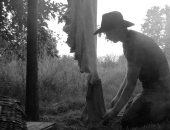
 7
7




This is how we make really lovely sheepskin floor rugs - using only soap, salt, oxalic acid, washing soda and oil. They're so cheap and easy to make and you mostly just need household products to do it.
There are different ways of curing, drying and tanning skins and fleeces, depending on what you want them for. But most use seriously nasty chemicals. Our method is simpler and much less toxic, and they end up perfect for floor rugs or for taking outside by the bonfire, but they are not soft enough for, say, making a coat (you'd need to tan them for that and that's a different process).
So this is a really easy and inexpensive method and you end up with something lovely and warm and friendly -- but it's a little bit stiff too. Ok?
The abattoir should just give you back the skins from your own sheep/lambs/goats/calves. And even if you don't have any sheep of your own, you should have no problem getting some -- the abattoir get next to nothing for them. Pick the best and cleanest you can though, and save yourself a lot of work.
YOU'LL NEED:
Salt -- the cheap and cheerful sort
Washing Soda -- again cheap and cheerful
Neatsfoot oil -- from your hardware shop or saddle shop
Saddle soap -- from the same places.
Oxalic acid -- through your chemist/drugstore or order online. This is the same acid that's found in rhubarb leaves so theoretically you could make your own, but it's very cheap to buy.
You will also need:
a large bath or barrel
Wire brush/comb -- hardware shop or petshop
Somewhere to hang the skins while they dry - which could be a week or more.
The precise amount you use isn't absolutely critical. For each 2 gallon bucket of water, we use approximately:
1 kilo salt (about 2lbs)
1 cup of powdered oxalic acid
Then later, for the first wash,
1 cup of washing soda crystals for each bucketful water.
WARNING -- these go through a smelly stage while they're drying out, so be warned!
Natural Small Batch Cheesemaking A Year in an Off-Grid Kitchen Backyard Dairy Goats My website @NourishingPermaculture






 6
6




Natural Small Batch Cheesemaking A Year in an Off-Grid Kitchen Backyard Dairy Goats My website @NourishingPermaculture






 6
6




[1] OBTAIN THE HIDE . . . no problem if you have your own sheep. Otherwise, check with someone in your area who does slaughtering. The commercial houses don't buy any sheepskins from our local man, and he'd been throwing them out . . . so we've asked him to save them for us.
Remember that sheepskins must be cooled before they're salted (how many hours this cooling takes depends on the weather). If someone is saving hides for you, ask him to spread them flesh side up and not to stack them. Then, pick up the skins as soon as possible and get them treated.
[2] SALT. First cut off any large pieces of meat and fat and trim ragged areas from the edges of the hide. Then apply a good half inch of plain granulated salt on every square inch of the pelt’s flesh side. Watch for folds . . . the skin can putrefy at those points and the smell will be terrible. And don't try to cut costs by skimping on the preservative! There's no need to do so anyway . . . we paid $1.95 for 100 pounds of fine salt at the grocery.
[3] SCRAPE OR FLESH. After four days brush the salt off and with a knife (or bare fingers, if necessary) pull away the thin adhering layers of meat and fat. Be careful not to tear the hide by getting too rough with your blade. A railing, sawhorse, or stall divider in the barn can serve as a fleshing beam on which to spread the skin while you work.
An hour of effort should get the worst of the scraping behind you. As the flesh pulls free you'll also be removing much of the muscular inner skin, which must eventually come off altogether to reveal the fine, already leather–like area beneath. You can attack this residue periodically while the hide is in the tanning solution.
[4] TAN. As I've already mentioned, the tanning solution we used consisted of 1 pint of salt and 2 ounces of oxalic to each gallon of water. It's possible to do as we did the first time and brush the chemical onto the flesh side of the skins. Keep the surface dampened by applying the mixture twice a day, and between applications stack the hides two-by-two with their back sides together (or fold a single pelt in half, flesh side in). This process should take four days.
Now that I've had a little experience, though, I think it’s preferable to just immerse the entire hide in the liquid. Then you can work from time to time at getting off that darned thin muscular layer without having to repaint each pelt with the solution every time (since you'll 'be submerging it again anyhow). The skins will be ready after 48 to 72 hours soaking.
If you go this route, of course, You'll have to find container — such as a large canning crock or wooden barrel that won't be eaten up by the acid solution. The drum liners which bag companies supply for the shipping of chemicals could, however, be used to adapt a plastic or metal vessel for your purpose.
[5] NEUTRALIZE AND WASH. Rinse the hide in water, and then give it two washings in several gallons of water which you've added a cup of washing soda. Follow this important step — which removes the acid from the skin — with several launderings in soap, detergent, or Woolite. Rinse until the water remains clear.
[6] DRY AND SOFTEN. Wring out as much water possible, since the wool acts like a sponge and would take forever to drip dry. If the weather is warm, you can hang hide outside. Otherwise, you can proceed — as we did — to a very cautious use of the clothes dryer on its lowest setting. (Lacking both a dryer and a sunny spell, you'll have to resort to a hair dryer, or lots of wringing and separating the wool to encourage the moisture to leave.) In any case, the fleece will dry first . . . and while it still feels a bit damp is a good time to apply saddle soap and neat's-foot oil or leather conditioner to the skin side of the pelt.
As the hide dries, keep pulling and stretching it in all directions. This separates the leather fibers and keeps the rug from hardening like a plank. The skin may look yellowish in areas where the surface is drying, but its hue will lighten as you work. The finished product should be white (or slightly tan from the oil dressing), soft and supple.
Don't think that you can just apply a bit of softening agent to the damp hide and have the skin turn out like glove leather. Pulling, rubbing, and stretching periodically while the drying goes on Is the only way to produce a nice inner surface rather than a brown board.
[7] COMB-OUT. As long as the skin and fleece are damp it's very easy to pull the wool out, so resist the temptation to get on with the brushing until the whole thing is dry. Then draw the fingers of fleece apart and groom the curly mass into a finished product (after which you. may want to add a backing to your rug). Shorter-wooled hides make great slippers, vests, and so on.
Natural Small Batch Cheesemaking A Year in an Off-Grid Kitchen Backyard Dairy Goats My website @NourishingPermaculture






 3
3




Natural Small Batch Cheesemaking A Year in an Off-Grid Kitchen Backyard Dairy Goats My website @NourishingPermaculture






 9
9




Amanda Parker
Magnolia Knoll Farms
English and French Angoras, Heritage poultry, fiber tools, and handcrafts!
Check out @magnoliaknollfarms on Facebook!
Located in Nelson, VA
 2
2




Natural Small Batch Cheesemaking A Year in an Off-Grid Kitchen Backyard Dairy Goats My website @NourishingPermaculture






 6
6




Shenanigans of the sheep and wooly sort.. And many more.. https://www.instagram.com/girlwalkswithgoats/
Papa always says, "Don't go away angry... just go away."
 5
5




Natural Small Batch Cheesemaking A Year in an Off-Grid Kitchen Backyard Dairy Goats My website @NourishingPermaculture






 8
8




"[6] Let the people, O God, confess to Thee: let all the people give praise to Thee: [7] The earth hath yielded her fruit. May God, our God bless us, [8] May God bless us: and all the ends of the earth fear Him." (Psalms 66/67)
 4
4




"The only thing...more expensive than education is ignorance."~Ben Franklin
"We can easily forgive a child who is afraid of the dark; the real tragedy of life is when men are afraid of the light." ~ Plato
 5
5





"We are the trees whom shaking fastens more." - George Herbert




"The only thing...more expensive than education is ignorance."~Ben Franklin
"We can easily forgive a child who is afraid of the dark; the real tragedy of life is when men are afraid of the light." ~ Plato
 4
4




Carla Burke wrote:Kate, how did this project go? I'm hoping you have pics?
Natural Small Batch Cheesemaking A Year in an Off-Grid Kitchen Backyard Dairy Goats My website @NourishingPermaculture






 1
1




"The only thing...more expensive than education is ignorance."~Ben Franklin
"We can easily forgive a child who is afraid of the dark; the real tragedy of life is when men are afraid of the light." ~ Plato
 2
2




Natural Small Batch Cheesemaking A Year in an Off-Grid Kitchen Backyard Dairy Goats My website @NourishingPermaculture






 3
3




"The only thing...more expensive than education is ignorance."~Ben Franklin
"We can easily forgive a child who is afraid of the dark; the real tragedy of life is when men are afraid of the light." ~ Plato
 4
4




Carla Burke wrote:Sorry I'm late to this party! I need to do (if they're still good, having been in the freezer, for months, with nothing being done, before going in there) 2 deer hides. One of the things I found, in my more recent searching, was using a pressure washer, to flesh the hide, instead of scraping. Seems like that would be WAY easier on my poor hands.
We have a pressure washer, so I'm equipped - but, has anyone here tried that?
"All we have to decide is what to do with the time that is given us." ~ Tolkien




Benedict Bosco wrote:Yes, a pressure washer will work, provided that it's of sufficient capacity. The little electric ones won't cut it. You'll also want a straight stream (0 degree) nozzle. I've fleshed both deer and a cow hide with it, and it works quite well. There's a sweet spot where it pretty much just cuts the flesh away. Just be warned...it's messy. You will have a large area that's soaking wet and covered in little bits of animal flesh. I also tried using it to take the hair off the deer hide...that sort of works, but it's easy to cut the hide in the process. There are probably better way to do that part of it.
"The only thing...more expensive than education is ignorance."~Ben Franklin
"We can easily forgive a child who is afraid of the dark; the real tragedy of life is when men are afraid of the light." ~ Plato
 2
2





"All we have to decide is what to do with the time that is given us." ~ Tolkien
 3
3




Natural Small Batch Cheesemaking A Year in an Off-Grid Kitchen Backyard Dairy Goats My website @NourishingPermaculture






 4
4




 5
5





|
Self destruct mode activated. Instructions for deactivation encoded in this tiny ad.
montana community seeking 20 people who are gardeners or want to be gardeners
https://permies.com/t/359868/montana-community-seeking-people-gardeners
|




